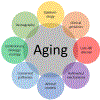Lack of consensus on an aging biology paradigm? A global survey reveals an agreement to disagree, and the need for an interdisciplinary framework
- PMID: 32693105
- PMCID: PMC7603428
- DOI: 10.1016/j.mad.2020.111316
Lack of consensus on an aging biology paradigm? A global survey reveals an agreement to disagree, and the need for an interdisciplinary framework
Abstract
At a recent symposium on aging biology, a debate was held as to whether or not we know what biological aging is. Most of the participants were struck not only by the lack of consensus on this core question, but also on many basic tenets of the field. Accordingly, we undertook a systematic survey of our 71 participants on key questions that were raised during the debate and symposium, eliciting 37 responses. The results confirmed the impression from the symposium: there is marked disagreement on the most fundamental questions in the field, and little consensus on anything other than the heterogeneous nature of aging processes. Areas of major disagreement included what participants viewed as the essence of aging, when it begins, whether aging is programmed or not, whether we currently have a good understanding of aging mechanisms, whether aging is or will be quantifiable, whether aging will be treatable, and whether many non-aging species exist. These disagreements lay bare the urgent need for a more unified and cross-disciplinary paradigm in the biology of aging that will clarify both areas of agreement and disagreement, allowing research to proceed more efficiently. We suggest directions to encourage the emergence of such a paradigm.
Keywords: Aged; Aging; Aging interventions; Aging mechanisms; Aging paradigm; Biology of aging; Epidemiology of aging; Evolution of aging; Philosophy of science.
Copyright © 2020 Elsevier B.V. All rights reserved.
Figures





References
-
- Belsky DW, Caspi A, Houts R, Cohen HJ, Corcoran DL, Danese A, Harrington H, Israel S, Levine ME, Schaefer JD, Sugden K, Williams B, Yashin AI, Poulton R, Moffitt TE, 2015. Quantification of biological aging in young adults. Proc. Natl. Acad. Sci 112, E4104–E4110. 10.1073/pnas.1506264112 - DOI - PMC - PubMed
-
- Calimport SRG, Bentley BL, Stewart CE, Pawelec G, Scuteri A, Vinciguerra M, Slack C, Chen D, Harries LW, Marchant G, Alexander Fleming G, Conboy M, Antebi A, Small GW, Gil J, Lakatta EG, Richardson A, Rosen C, Nikolich K, Wyss-Coray T, Steinman L, Montine T, de Magalhães JP, Campisi J, Church G, 2019. To help aging populations, classify organismal senescence. Science (80-. ). 10.1126/science.aay7319 - DOI - PMC - PubMed
Publication types
MeSH terms
Grants and funding
LinkOut - more resources
Full Text Sources
Medical

